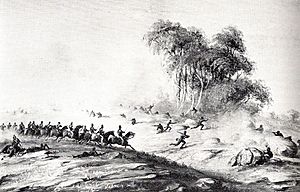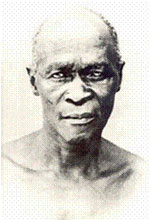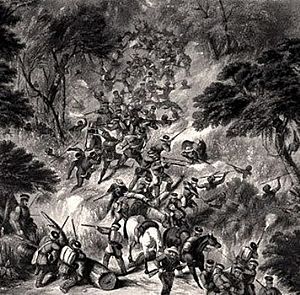Eighth Xhosa War facts for kids
Quick facts for kids Eighth Xhosa War |
|||||||
|---|---|---|---|---|---|---|---|
| Part of the Xhosa Wars | |||||||
 Resistance fighters defend a stronghold in the forested Water Kloof during the Eighth Xhosa War in 1851. Xhosa, Kat River Khoi-khoi and some army deserters are depicted |
|||||||
|
|||||||
| Belligerents | |||||||
Khoikhoi forces
|
|||||||
| Commanders and leaders | |||||||
| Chief Maqoma | |||||||
The Eighth Xhosa War was a major conflict between the British Empire and the Xhosa and Khoikhoi forces. It took place from 1850 to 1853. This war was the eighth in a series of nine Xhosa Wars fought in southern Africa.
Contents
Why Did the War Start?
Many Xhosa people were forced to move by Governor Harry Smith. They had to cross the Keiskamma River. These people joined others already living there. This caused overcrowding and made life very hard for everyone.
Some Xhosa who stayed in the colony were moved to towns. They were encouraged to live like Europeans. Governor Smith also took over the independent Orange Free State. He dealt harshly with the Boer leaders there. This made many people in the Cape Colony unhappy with him.
To pay for these actions, Smith put very high taxes on local people. He also cut the number of soldiers in the Cape to less than 5,000.
In June 1850, there was a very cold winter and a bad drought. At this time, Smith ordered many Xhosa families to leave the Kat River area.
The Prophet Mlanjeni's Influence
This war became known as "Mlanjeni's War." Mlanjeni was a prophet among the Xhosa people who had lost their homes. He told them that British bullets would not harm them. Because of his words, many Xhosa started to leave the towns. They gathered in their tribal areas, ready for conflict.
How the War Began
Governor Sir Harry Smith believed that the Xhosa chiefs were causing the unrest. He decided to meet with the main chiefs. However, Chief Sandile refused to come to a meeting outside Fort Cox. So, Governor Smith removed him from his position and declared him a wanted person.
On December 24, a group of 650 British soldiers was ambushed. This happened in the Boomah Pass by Xhosa warriors. The soldiers had to retreat to Fort White. They faced heavy fire and lost 42 men.
The very next day, Christmas, something unexpected happened. Xhosa people, who seemed friendly, entered towns to join the celebrations. But at a signal, they attacked the settlers who had invited them. Many settlers were killed. After this attack, most of the Ngqika Xhosa joined the war.
Early Days of the Conflict
While the Governor was still at Fort Cox, Xhosa forces moved into the colony. They surrounded him at the fort. The Xhosa burned British military villages along the border. They also captured the post at Line Drift.
Meanwhile, the Khoi people from the Blinkwater River Valley and Kat River Settlement rebelled. Their leader was Hermanus Matroos, who was half-Khoi and half-Xhosa. They successfully captured Fort Armstrong. Many members of the "Kaffir Police" also left their jobs. This police force was created by the British to stop cattle theft. These police joined the Xhosa fighting groups. For a short time, it seemed like all Xhosa and Khoi people in the eastern Cape were fighting the British.
Harry Smith eventually fought his way out of Fort Cox. He got help from the local Cape Mounted Riflemen. But he realized he had lost the support of most of his local allies. His actions had turned the Burghers, Boer Commandos, Fengu, and Khoi into enemies. These groups usually helped defend the Cape. Even some units of the loyal Cape Mounted Riflemen, who were of Khoi descent, joined the Xhosa rebels.
The British Fight Back (January 1851)
After their first successes, the Xhosa faced some difficulties. Xhosa forces were pushed back in separate attacks on Fort White and Fort Hare. Also, on January 7, Hermanus and his supporters attacked the town of Fort Beaufort. A small group of soldiers and local volunteers defended the town. The attack failed, and Hermanus was killed.
The Cape Government finally agreed to gather a force of local gunmen. These were mainly Khoi people. They helped protect the border. This allowed Smith to use some of his imperial troops for attacks.
By the end of January, the British started getting more soldiers. These reinforcements came from Cape Town. A force led by Colonel Mackinnon moved north from King William's Town. They were able to resupply the forts at Fort White, Fort Cox, and Fort Hare. With new men and supplies, the British drove out Hermanus's rebel forces. These forces were now led by Willem Uithaalder. They were pushed west towards the Amatola Mountains. Over the next few months, more and more British troops arrived. This helped the British, who were greatly outnumbered. Smith could then lead sweeps across the border region.
In 1852, a ship called HMS Birkenhead sank near Gansbaai. It was bringing more soldiers to the war. As the ship went down, the men, mostly new recruits, stood quietly in lines. The women and children were put into lifeboats. The men stayed in formation as the ship sank. Over 300 of them died.
The War's End
Chief Maqoma and his forces set up their base in the forested Waterkloof area. From this strong position, they raided nearby farms and burned homes. Maqoma's main base was on Mount Misery. This was a natural fortress between the Waterkloof and Harry's Kloof. The fighting in the Waterkloof lasted for two years. Maqoma also led an attack on Fort Fordyce. He caused heavy losses to Sir Harry Smith's forces.
In February 1852, the British Government decided that Sir Harry Smith's poor leadership had caused much of the violence. They ordered him to be replaced by George Cathcart, who took command in March. For the next six months, Cathcart ordered searches for rebels across the countryside. In February 1853, Sandile and the other chiefs finally surrendered.
The Eighth Xhosa War was the most difficult and harsh in the series of Xhosa wars. It lasted over two years. It ended with the complete control of the Ciskei Xhosa by the British.




